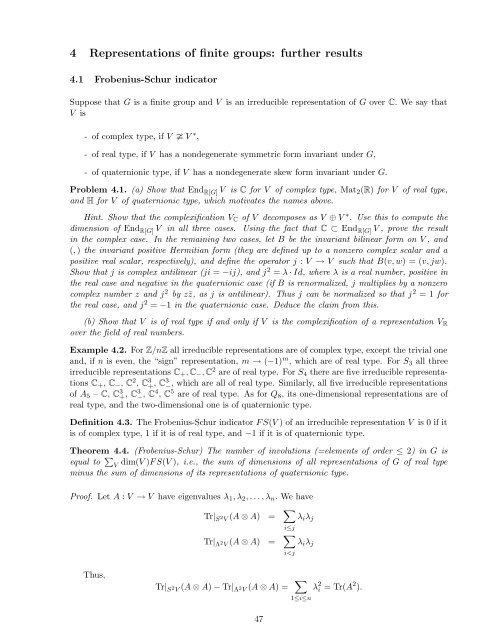Lecture notes for Introduction to Representation Theory
Lecture notes for Introduction to Representation Theory
Lecture notes for Introduction to Representation Theory
You also want an ePaper? Increase the reach of your titles
YUMPU automatically turns print PDFs into web optimized ePapers that Google loves.
4 <strong>Representation</strong>s of finite groups: further results<br />
4.1 Frobenius-Schur indica<strong>to</strong>r<br />
Suppose that G is a finite group and V is an irreducible representation of G over C. We say that<br />
V is<br />
- of complex type, if V V ⊕ ,<br />
- of real type, if V has a nondegenerate symmetric <strong>for</strong>m invariant under G,<br />
- of quaternionic type, if V has a nondegenerate skew <strong>for</strong>m invariant under G.<br />
Problem 4.1. (a) Show that End R[G] V is C <strong>for</strong> V of complex type, Mat 2 (R) <strong>for</strong> V of real type,<br />
and H <strong>for</strong> V of quaternionic type, which motivates the names above.<br />
Hint. Show that the complexification V C of V decomposes as V V ⊕ . Use this <strong>to</strong> compute the<br />
dimension of End R[G] V in all three cases. Using the fact that C → End R[G] V , prove the result<br />
in the complex case. In the remaining two cases, let B be the invariant bilinear <strong>for</strong>m on V , and<br />
(, ) the invariant positive Hermitian <strong>for</strong>m (they are defined up <strong>to</strong> a nonzero complex scalar and a<br />
positive real scalar, respectively), and define the opera<strong>to</strong>r j : V ⊃ V such that B(v, w) = (v, jw).<br />
Show that j is complex antilinear (ji = −ij), and j 2 = ∂ · Id, where ∂ is a real number, positive in<br />
the real case and negative in the quaternionic case (if B is renormalized, j multiplies by a nonzero<br />
complex number z and j 2 by zz¯, as j is antilinear). Thus j can be normalized so that j 2 = 1 <strong>for</strong><br />
the real case, and j 2 = −1 in the quaternionic case. Deduce the claim from this.<br />
(b) Show that V is of real type if and only if V is the complexification of a representation V R<br />
over the field of real numbers.<br />
Example 4.2. For Z/nZ all irreducible representations are of complex type, except the trivial one<br />
and, if n is even, the “sign” representation, m ⊃ (−1) m , which are of real type. For S 3 all three<br />
irreducible representations C + , C − , C 2 are of real type. For S 4 there are five irreducible representations<br />
C + , C − , C 2 , C 3 +, C 3 , which are all of real type. Similarly, all five irreducible representations<br />
of A 5 – C, C<br />
3<br />
+ , C 3 , C 4 −<br />
, C 5<br />
− are of real type. As <strong>for</strong> Q 8 , its one-dimensional representations are of<br />
real type, and the two-dimensional one is of quaternionic type.<br />
Definition 4.3. The Frobenius-Schur indica<strong>to</strong>r F S(V ) of an irreducible representation V is 0 if it<br />
is of complex type, 1 if it is of real type, and −1 if it is of quaternionic type.<br />
Theorem 4.4. (Frobenius-Schur) The number of involutions (=elements of order ∗ 2) in G is<br />
equal <strong>to</strong> ⎨ V<br />
dim(V )F S(V ), i.e., the sum of dimensions of all representations of G of real type<br />
minus the sum of dimensions of its representations of quaternionic type.<br />
Proof. Let A : V ⊃ V have eigenvalues ∂ 1 , ∂ 2 , . . . , ∂ n . We have<br />
<br />
Tr|<br />
S 2 V (A A) = ∂i ∂ j<br />
i→j<br />
Tr|<br />
2 V (A A) =<br />
<br />
∂i ∂ j<br />
i

















